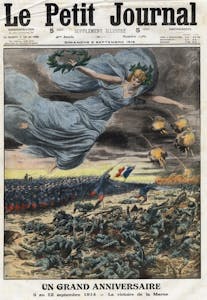110-year-old Renault taxi recalls the Battle of the Marne

It’s rare for a daily newspaper reporter to be able to revisit a story that he wrote 30 years ago and find out how it turned out. At the very least it suggests I never found a real job in the meantime. It’s even less likely that, as I combed the darkest recesses of my memory to remember who/when/where, I found that a fellow ink-stained wretch quite recently answered all my questions but one.
Back in 1992, I was the Automotive Editor at Portland’s The Oregonian, the state’s largest daily paper, located in Portland. Most of my time was spent sharpening my rapier-like wit in critiques of new cars, which provided the Business Editor with a near full-time job defending me against the newspaper’s Editor.
“Ah don’t see why we need to upset our advertisers like this,” she said, shortly before turning Wheels section into “advertorial”—two words which any grammarian knows cannot be combined, certainly not by me.
Meanwhile, as a classic car enthusiast, some historical stories blew into my face like a bee inside a motorcycle helmet, and I couldn’t shoo them away. One of my favorites was the discovery in town of a 1910 Renault AG taxi, which had actually taken part in the first battle of the Marne in 1914. It was exhumed from storage and brought to my old restorer friend and fellow Englishman Peter Price.
The Germans had swept through Belgium with their Schlieffen Plan at the start of WWI, and in 30 days they were 30 miles from Paris on September 3, 1914, when they reached the River Marne. A split was opening in the German lines between the First and Second Army, and the Germans had overreached themselves. General Josef-Simon Gallieni was defending Paris and had received 3000 Zouave infantrymen from North Africa, but had no way to get them to the front.

In an enterprising move, he commandeered 600 Parisian taxis, the first recorded use of civilian vehicles for military purposes. The Zouaves arrived at the Marne on September 6, and by the 14th the Germans had been halted. They would not reach Paris for 26 years, until the Nazis invaded in June 1940. Those same Marne taxis also transported wounded soldiers back from the front.

Twenty years later, in 1934, the Forty & Eight committee of Portland’s American Legion Post Voiture 25 was mulling a memorial to the Great War and the doughboys who lost their lives. (“Forty & Eight” stands for the railroad cars which took 40 men, or eight horses, to the front.) The group decided to find one of the Marne taxis and asked member Byron Beattie to look for one on a trip back to France with his French wife.
By 1934 the old two-cylinder Renault AG taxis were long out of service, but the American Legion post in Paris found three survivors of the strangest charge of WW I. The best example—registered 44 49 E2—belonged to Pierre Pautas, a cabbie who actually drove one to the Marne. The cab that Pautas was selling was captured by the Germans and not recovered until 1917.
The government auctioned off the commandeered taxis at the end of the war and Pautas went back to work as a Parisian cabbie in this car. By 1934, his Renault had been retired for some years, but he kept it sentimentally and rented it out for movies. Pautus was asking the then-ridiculous sum of $100, and Beattie reckoned he needed another $50 to ship it to Le Havre, where the French Line would ship it free to America.
Beattie wrote an airmail letter to Legion Chef de Gare Rex Parelius in Portland and reported ‘the boys are fine but broke.” He asked if the money for the cab could be sent, saying he would let the deal slide otherwise. But the money arrived, and Pautas drove the retired cab to the station, “making the sound of a thousand armored knights falling downstairs,” according to the Paris edition of the New York Herald. Pathe News even shot film of the occasion, now in the Getty collection (sadly without sound).
The Renault arrived in Portland on October 28, 1935, aboard the French liner San Antonio. The arrival was a “cause celebre” with a KGW radio show and speechifying from Governor Charles Martin, Portland Mayor Joseph Carson, U.S. Senator Frederick Steiwer, and Gilbert Maqueron, a representative of the French government.
The old Renault taxi retired, save for appearances at Veterans Day parades and other shows, but it gradually deteriorated. Legion member Don Downing maintained it, but it was a losing battle, and in 1992 the Legion decided something should be done.
The Forty & Eight group started a restoration fund and asked English restorer Peter Price for an estimate of the restoration cost. “It’s basically a huge pattern,” Price said. “Who knows what we will have to do; we may have to go as far as cutting gears for it.” He estimated a frame-off restoration would take 2000–2500 hours.

At that point the Renault was almost complete, but everything needed repair. The original cellulose brush paint was cracked and crazed, the body’s wood framing was warped and rotted, the upholstery was vinyl, one rear window was missing, and the other window was reinforced with chicken wire. The cylinder head on the 800cc two-cylinder motor was cracked, and the 23-inch wooden wheels had been replaced with 19-inch wheels.
Though battered, the Renault was still an attractive design; a Salamanca style with a convertible top over the driver and at the very rear. There was a solid carriage roof between the two, plus a door on each side and two jump seats in the rear. The driver sat on the right. There were no instruments in the dash. Coffin-nose Renaults had the radiator behind the engine and the gas tank behind that. The gas filler was in located in the center of the dash, and the radiator cap was in front of the windshield.
Clutch, brake, and accelerator pedals were normal—many cars had the accelerator between the other two in those days—but the gear shift looked like a handbrake on the driver’s right. The gears were epicyclic, like a motorcycle, so the lever was pulled straight back for 1-2-3 and still further for reverse. The handbrake was outside the body; pushing forward applied it, so the driver could not alight until it was engaged and clear of the door. Only the rear wheels were braked.

There were no headlights as such, but acetylene carriage lights engraved with the district the taxi worked—Levalloiss—were mounted high on the body to illuminate the curb and the entry as well. With a top speed of around 25 mph, headlights wouldn’t be missed much anyway. The two-cylinder engine displaced 800cc, generating about eight horsepower. “But it must have been economical,” Price said with a chuckle.
And that’s the end of the Oregonian’s 1992 story. There’s no word on how much work Peter Price did on the taxi, and he died about 15 years ago. The trail went cold until John Baker of the Portland Tribune wrote a story in October 2019, when Legionnaire Don Downings—who had been the taxi’s caretaker for 30 yearss—decided to pass the car on to its next keeper. It is now in the hands of another Legion Post in Vancouver, Washington. Downing told Baker that as far as he knew, this is the last proven survivor of the 1914 charge to the River Marne. Though a number of Renault AG taxis have changed hands at European auctions, I have never seen definitive proof that they were Marne survivors.
We may assume there is a genuine survivor in the Louvre, or perhaps in Renault’s museum, but the provenance on this car is literally bulletproof (well not quite; several bullet holes were preserved during the restoration.) So far, the current location of taxi #44 49 E2 has proved elusive, but I’ll continue the hunt—and let you know when I find it.

